
Rent Payments in Affordable Housing During the Pandemic: The Role of Rental Subsidies and the Safety Net
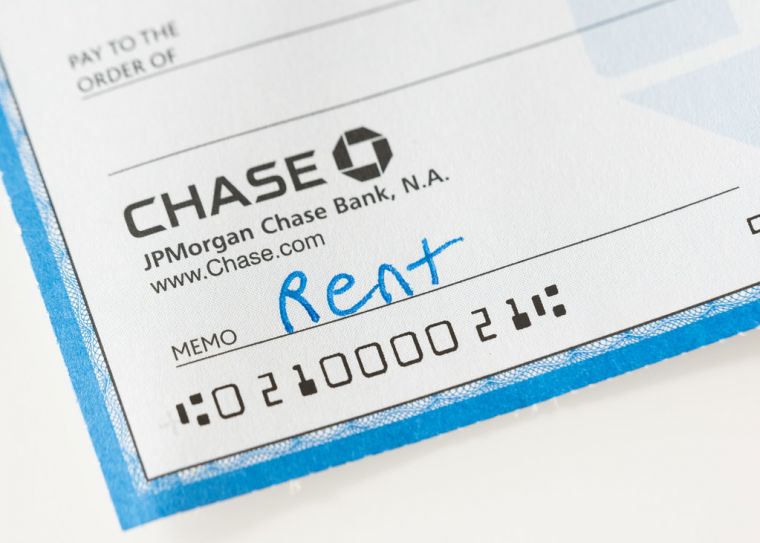
Photo Credit: Daniel Foster
As members of the Housing Crisis Research Collaborative, the NYU Furman Center and the Terner Center for Housing Innovation at UC Berkeley conducted an analysis of rental payments during the pandemic among a set of primarily affordable portfolios and compared the size and frequency of rent arrears for households that receive housing subsidies that adjust with income (like Housing Choice Vouchers) and unsubsidized households. Notably, many households in the sample data benefit from affordable, regulated rents, regardless of whether or not they receive a federal or local housing subsidy. A new data brief examines trends in the number of households that missed at least one full rent payment, one of the clearest measures to compare trends across the bi-coastal samples.
The comparative analysis suggests that nonpayment rates increased for both groups after the start of the pandemic. Landlords with subsidized tenants benefitted from the protective effects of the subsidy portion which lessened the economic impact of the pandemic. This analysis highlights the risk of housing instability and evictions that households may face without access to rental assistance, while also recognizing the necessity of future research to examine the effects of rent relief disbursement.
Key Takeaways
Nonpayment by household type:
- Nonpayment rates were higher overall in the New York City sample even before the pandemic, suggesting compositional differences in the portfolios and tenants.
- In both locations, the share of households missing a full rent payment in a given month increased sharply immediately after the economic shutdown in March 2020 and remained at heightened levels throughout the rest of 2020.
- Prior to the pandemic, subsidized households had higher levels of nonpayment than unsubsidized households, perhaps due to much lower incomes and greater precarity.
- Both subsidized and unsubsidized households saw increases in nonpayment of rent after the onset of the pandemic, with unsubsidized households hit particularly hard in the California sample.
- Where fixed income receipt is observable (in the California sample), households with fixed incomes had lower rates of nonpayments both prior to and after March 2020, and a smaller increase in nonpayment rate after the onset of the pandemic.
The protective effects of housing subsidies and income supports:
- While both subsidized and unsubsidized households experienced marked increases in nonpayment rates during the pandemic, subsidized households accrued lower levels of rental arrears, as their tenant-charged rent is substantially lower than that of unsubsidized tenants.
- Unsubsidized households without fixed incomes had the greatest increase in nonpayment rates and accrued higher levels of arrears during the pandemic.
Findings
While nonpayment rates were higher overall in NYC before the pandemic, nonpayments increased in both samples after the shutdown and remained at the heightened levels through the end of 2020
This increase in nonpayment remained through the end of 2020, with differences across the samples. The percentage of households that missed a rent payment in the CA sample increased to t 5 percent which was more than double its pre-pandemic level of about 2 percent. The NYC percentage increased to close to 15 percent which is around 5 percentage points higher than its pre-pandemic level.
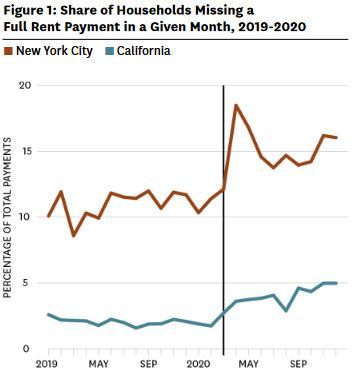
Subsidized households had higher nonpayment rates than unsubsidized households before the pandemic
Analysis of the rent payment data suggests that both the CA and NYC samples had similar patterns of subsidized households showing larger pre-pandemic nonpayment rates. The CA sample revealed differences in typical incomes for subsidized and unsubsidized households (approximately $15,000 and $38,400, respectively). Because of the lower average income levels of subsidized households, these households are likely at a higher risk of economic uncertainty and income insecurity.
Nonpayment rates increased after the shutdown for both subsidized and unsubsidized households in both samples
This trend suggests that housing subsidies did not fully protect subsidized households from the economic effects of the pandemic. Possible explanations for the increases in nonpayment by subsidized households include difficulties with income certification, other financial strains that do not qualify as changes in income (like helping a family member experiencing economic stressors), or the protections afforded under eviction moratoria.
In California, households without a source of fixed income experienced the greatest increases in nonpayments
Within the CA sample, the majority of subsidized households had a fixed income source, compared to just one-quarter of unsubsidized households. Households that received at least one stable source of income (such as a Social Security or Supplemental Security Income) displayed lower nonpayment rates, regardless of subsidy status, than households without fixed incomes.
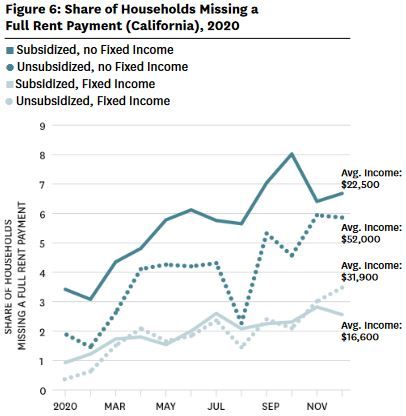
Households in both the NYC and CA samples were more likely to miss multiple rent payments after the onset of the pandemic, regardless of subsidy status
Within the CA sample, before the onset of the pandemic households that missed rent were more likely to miss only one payment; afterward, however, the share of households missing both one rent payment and multiple rent payments increased notably. In the NYC sample, households who missed full rent payments prior to the pandemic were more likely to miss at least two monthly rent payments and during the pandemic, the share of households missing multiple rent payments increased further.

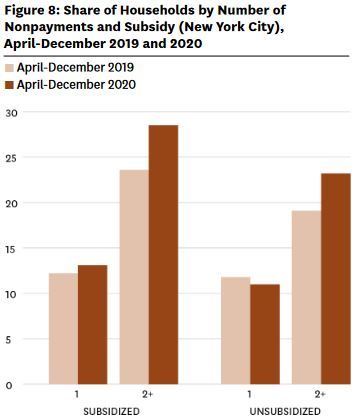
In both NYC and CA, unsubsidized households accrued higher arrears during 2020
The average subsidized household in the California sample amassed $344 of rental arrears between April and December 2020, whereas the average unsubsidized household in California accrued about $1,341 of rental arrears during the same period. In NYC, subsidized households accrued about $1,205 on average compared to an average of $2,144 for unsubsidized households.
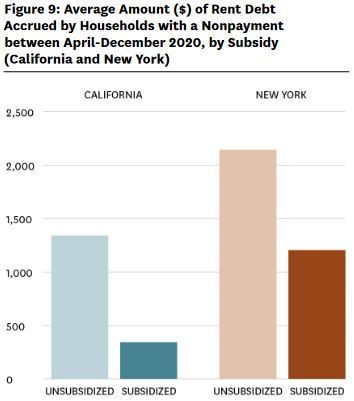
From an owner’s perspective, rental subsidies have a buffering effect on the total rent debt that may accumulate during an economic downturn
When subsidized tenants were not able to pay their portion of rent, owners could still receive the subsidy portion of the rent. These subsidies helped to buffer owners from some of the economic impacts of increases in nonpayment rates.
Conclusion
The findings of this analysis build on a variety of research looking at changes in rental debt over the course of the pandemic. While this analysis points to some of the protective properties of housing subsidies for low-income tenants (as they lower the cost of rent and adjust according to changes in income), it also suggests that tenants with those subsidies still struggled to pay their rent portion, particularly during the pandemic. Subsidized households may struggle due to lower incomes and greater financial precarity, and the increase in nonpayment for this group during the crisis may point to gaps in protections against economic shocks. A key question that policymakers continue to face is how to bridge the gap between the expiration of eviction moratoria and the slow rollout of emergency rent relief. Making sure renters that need assistance have the support and resources to access it will be central to diverting a spike in evictions. But even after emergency assistance has been expended, these findings also point to the role expanded durable subsidies could play in stabilizing vulnerable low-income renters longer term.


